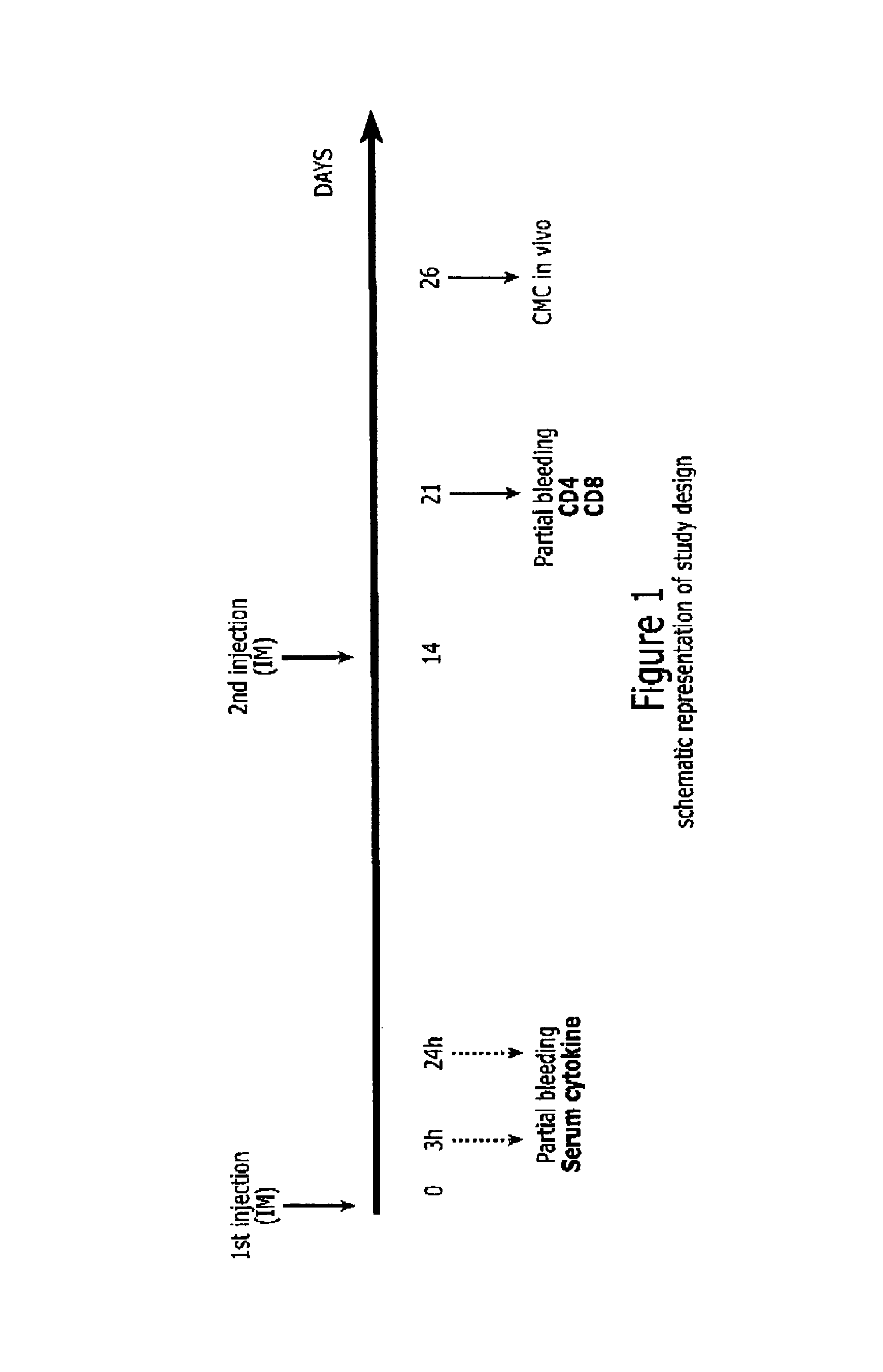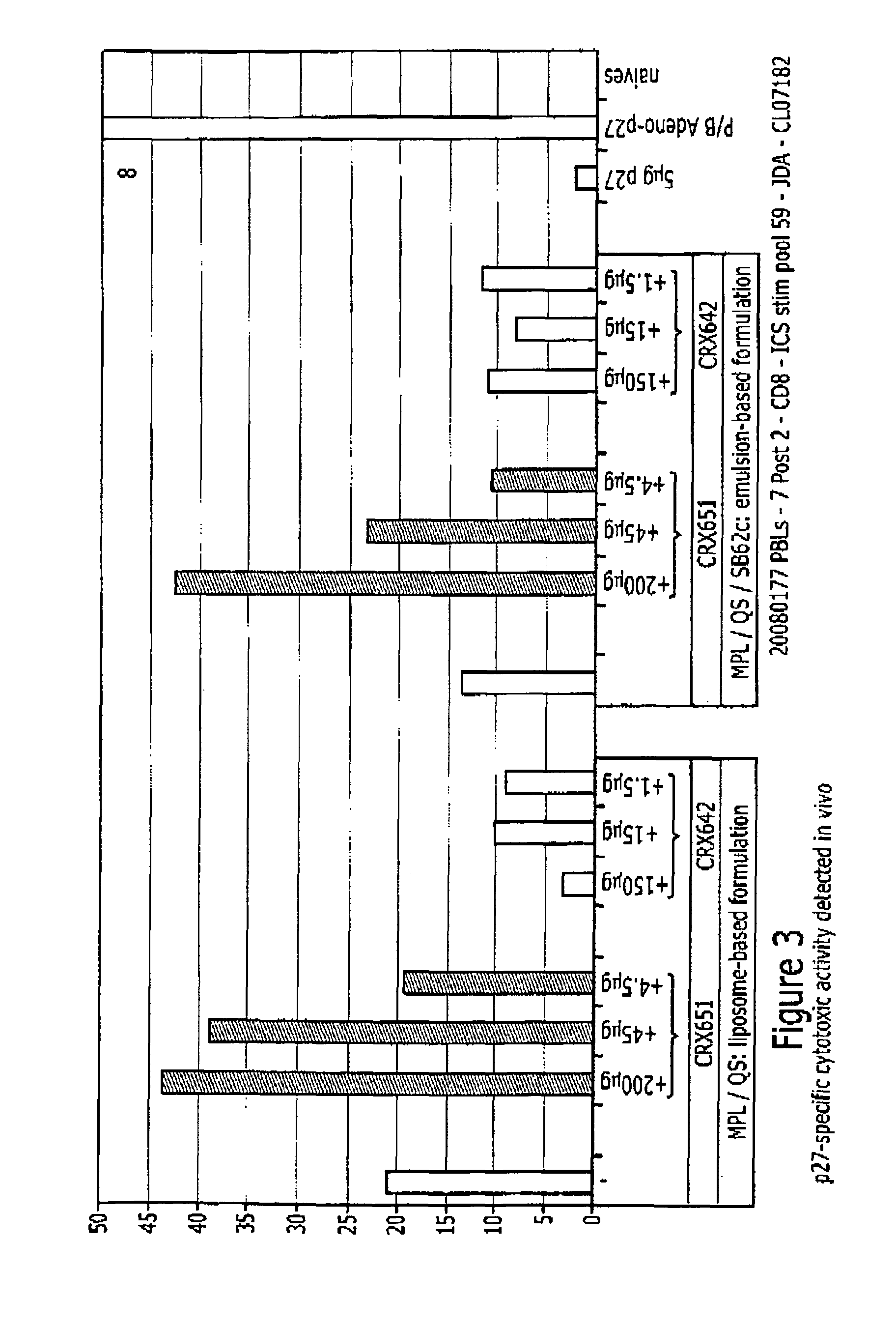Lipidated imidazoquinoline derivatives
a technology of imidazoquinoline and derivatives, which is applied in the field of new adjuvant compounds, can solve the problems of reducing vaccine potency, difficult design of vaccine adjuvants, and relatively low activity of imiquimod
- Summary
- Abstract
- Description
- Claims
- Application Information
AI Technical Summary
Benefits of technology
Problems solved by technology
Method used
Image
Examples
example 2
Preparation of 4-Amino-1-(4-hydroxybutyl)-2-ethoxymethyl-1H-imidazo[4,5-c]quinoline hydrochloride (Compound (III), R1═CH2OCH2CH3, n=4)
[0043]
[0044](1) A suspension of 4-hydroxy-3-nitroquinoline (Gerster et al. J Med Chem 2005, 48, 3481) in DMF (0.7 M) was treated dropwise with POCl3 (1.2 eq) and stirred at 50° C. for 30 min. The reaction mixture was poured into ice-water and extracted twice with CH2Cl2. The combined organic layers were washed with water, dried (Na2SO4) and concentrated. The crude product obtained was added to a solution of 4-amino-butanol (1.3 eq) and triethylamine (1.9 eq) in EtOH and heated to reflux for 15 min. After concentration, flash chromatography on silica gel (gradient elution, 2→4% MeOH—CHCl3) afforded 4-(4-hydroxybutyl)amino-3-nitroquinoline as a yellow solid in 97% yield.
[0045](2) A solution of the compound prepared in (1) above in EtOAc (0.1 M) was hydrogenated in the presence of 5% Pt / C (5% w / w) and MgSO4 (1.5 eq) at 50 psig for 6 h. The reaction mixtu...
example 3 (
L1)
Preparation of 4-Amino-1-[2-(1,2-dipalmitoyl-sn-glycero-3-phospho)ethyl]-1H-imidazo[4,5-c]quinoline (Compound (I), R1═H, Y═W═X═O, n=2, m=1, R2═R3=n-C15H31CO)
[0049]
[0050]Compound L1 was prepared in 80% yield following the general procedure described in Example 1 above: 1H NMR (CDCl3—CD3OD, 400 MHz): δ 8.22 (s, 1H), 8.16 (d, 1H), 7.41 (t, 1H); 7.21 (t, 1H), 6.92 (d, 1H), 5.26 (m, 1H), 4.82 (bs, 2H), 4.67 (bs, 2H), 4.42 (dd, 1H), 4.20 (dd, 1H), 4.05 (t, 2H), 3.14 (q, 1H), 2.31 (m, 4H), 1.59 (m, 4H), 1.25 (m, 48H), 0.88 (m, 6H); 13C NMR (CDCl3—CD3OD, 100 MHz): δ 173.6, 173.2, 148.1, 145.8, 134.5, 133.9, 129.3, 125.5, 124.5, 118.4, 112.3, 100.3, 77.2, 70.1, 70.0, 63.5, 62.3, 45.9, 34.1, 33.9, 31.7, 29.5, 29.5, 29.3, 29.2, 29.1, 29.1, 28.9, 28.9, 24.7, 24.7, 22.5, 13.9, 8.3. HRMS calcd for [M+H]+ 859.5714, found 859.5688.
example 4 (
L2)
Preparation of 4-Amino-1-[2-(1,2-dipalmitoyl-sn-glycero-3-phospho)ethyl]-2-butyl-1H-imidazo[4,5-c]quinoline (Compound (I), R1=n-C4H9, Y═W═X═O, n=2, m=1, R2═R3=n-C15H31CO)
[0051]
[0052]Compound L2 was prepared in 78% yield following the general procedure described in Example 1 above: 1H NMR (CDCl3—CD3OD, 400 MHz): δ 8.23 (bs, 1H), 7.39 (t, 1H), 7.22 (bs, 1H), 6.93 (bs, 1H), 5.25 (m, 1H), 4.7 (bs, 2H), 4.6 (bs, 2H), 4.42 (dd, 1H), 4.19 (dd, 1H), 4.04 (t, 2H), 3.06 (bs, 2H) 2.32 (m, 4H), 1.96 (p, 2H) 1.59 (m, 6H) 1.26 (m, 48H), 1.07 (t, 3H), 0.88 (m, 6H); 13C NMR (CDCl3—CD3OD, 100 MHz): δ 173.6, 173.2, 157.2, 147.4, 135.2, 133.6, 128.8, 124.2, 123.6, 120.9, 118.2, 112.2, 77.2, 70.0, 69.9, 63.2, 62.2, 46.3, 33.9, 33.7, 31.6, 29.3, 29.3, 29.3, 29.1, 29.0, 28.95, 28.9, 28.8, 28.7, 28.6, 27.0, 24.5, 24.5, 22.3, 22.1, 13.6, 13.4. HRMS: calcd for [M+H]+ 915.6340, found 915.6309.
PUM
| Property | Measurement | Unit |
|---|---|---|
| pH | aaaaa | aaaaa |
| pH | aaaaa | aaaaa |
| temperature | aaaaa | aaaaa |
Abstract
Description
Claims
Application Information
 Login to View More
Login to View More - R&D
- Intellectual Property
- Life Sciences
- Materials
- Tech Scout
- Unparalleled Data Quality
- Higher Quality Content
- 60% Fewer Hallucinations
Browse by: Latest US Patents, China's latest patents, Technical Efficacy Thesaurus, Application Domain, Technology Topic, Popular Technical Reports.
© 2025 PatSnap. All rights reserved.Legal|Privacy policy|Modern Slavery Act Transparency Statement|Sitemap|About US| Contact US: help@patsnap.com



